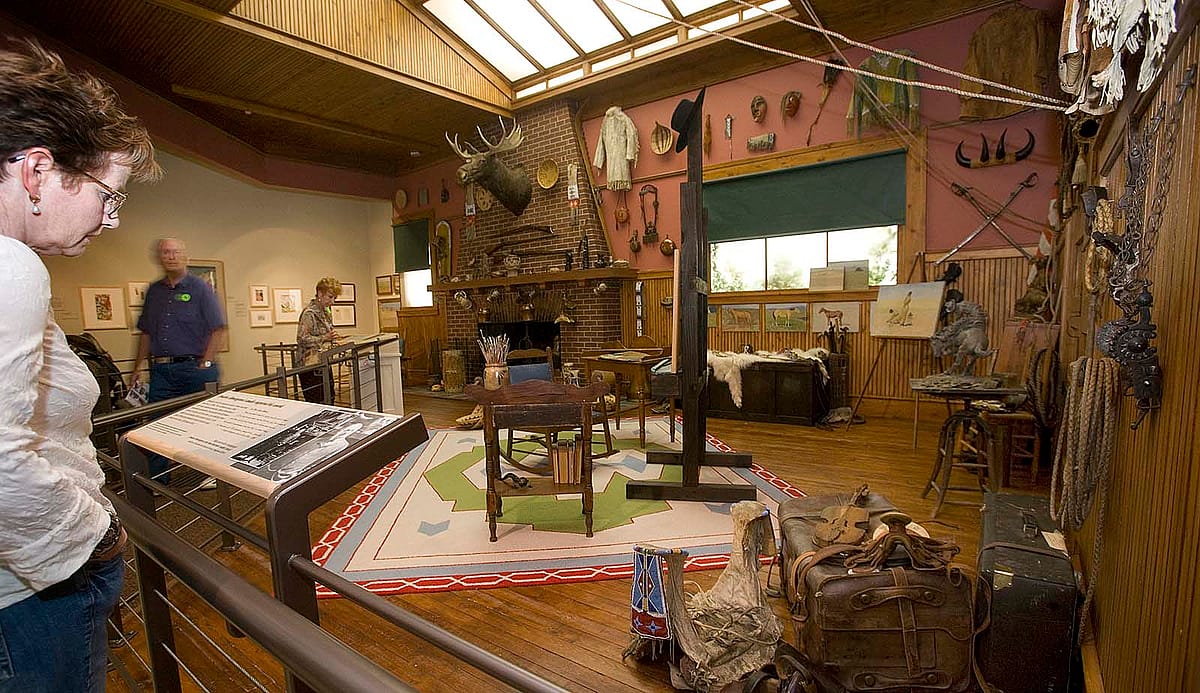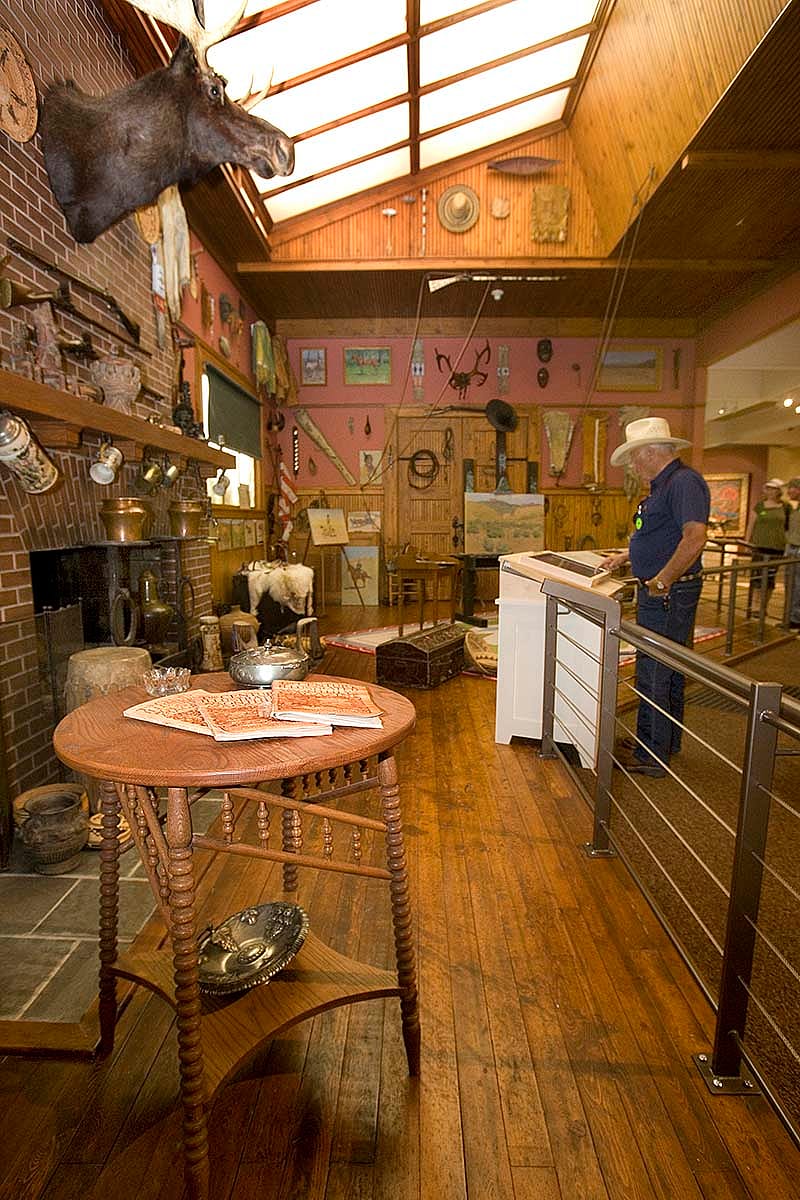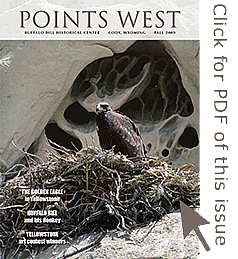
Seeing the West in a Whole New Way – Points West Online
Originally published in Points West magazine
Fall 2009
Seeing the West in a Whole New Way: The 2009 Whitney Museum Reopening
By Laurel Eatherly
A blast from the past this week… It’s hard to believe it’s been 12 years since our Whitney Western Art Museum reopened after a complete renovation. In this article from 2009, a summer intern shares her first impressions of the redesigned museum, which continues to grow and change as artwork is rotated in and out of the space.
I’ll be the first to admit, with some embarrassment, that I have never been familiar with art of the American West until very recently.
Why am I embarrassed? It’s like this: I’ve lived most of my life here in Cody, Wyoming, home to the Whitney Western Art Museum and the most comprehensive collection of western art in the world. I had visited the gallery countless times growing up, while accompanying out-of-town guests, enjoying the holiday open house, or attending class field trips. Even after all those years and all those visits, however, I never developed much knowledge or interest in the art I saw.
That all changed in May when I began my summer internship in the Buffalo Bill Historical Center’s [now Buffalo Bill Center of the West] public relations department. From the first hour I spent on the job, I knew it was an exciting time to be here at the Center. The Whitney—closed for reinstallation back in October 2008—would re-open to the public in a few short weeks in celebration of its 50th anniversary, and a sense of anticipation filled the building. As June 21, 2009, neared, I found it impossible not to be just as excited and curious as everyone else. I still knew close to nothing about the art itself; but, like some crazed game show contestant, I simply had to see what was behind those doors.
Finally, a couple of weeks before the public opening, I had the chance to take a sneak-peek inside. As I wandered through, I tried hard to remember the “old Whitney” and compare it with the new: What painting used to hang in that spot? What color were those walls? Where had that sculpture been? I quickly realized I could no longer remember many details of the former space. Still, even if I couldn’t recall the nuances of how the museum had once looked, I couldn’t help but notice a difference in how the gallery now felt.
What had changed? Nothing much, really—except the whole atmosphere of the place. The ceilings were higher. The lights were softer. The floors were carpeted. The walls were colorful. While the gallery definitely felt more spacious, somehow it also felt intimate, even cozy. With walls painted in shades of red, blue, green, and yellow, each distinctively themed area drew me in to spend some quality time with its subjects. I was immersed in rugged landscapes one minute, surrounded with portraits of western heroes the next. Despite standing in a room with 275 masterpieces, I never had to think too hard about what to gaze upon next, for one space seemed to lead naturally to another.
I’ve been to my share of art museums, but as much as I may have enjoyed my time in each of them, I’ve often had a nagging feeling that maybe I wasn’t quite qualified to be there. After all, I’ve never taken a course in art history, and the last time I can remember painting or sculpting anything of my own was in the seventh grade. Sometimes, as I stand before a piece of artwork, I wonder if I’m failing to notice something important, or if I understand the art the way I’m supposed to. I have a hunch I’m not the only person who’s ever felt this way, either. Like me, plenty of people find art downright intimidating; the Whitney Museum is the perfect place for us.
That’s because, thanks to the gallery’s thematic layout, it’s easy to put the art into context. The horses are with the horses, and the cowboys are with the cowboys. Even with no previous knowledge of artistic techniques, I can see how various artists chose vastly different approaches to depicting the same aspect of the West. The juxtaposition of two paintings, Custer’s Last Stand, by Edgar S. Paxson, and The Battle of Greasy Grass, by Allan Mardon, is especially memorable. When situated across from one another, it’s easy to see two contrasting perspectives on the same historic event. Both paintings are rich in detail, and a touch-screen kiosk for each painting helps me study some of the individuals the artists portrayed.
The opportunities for interactive learning don’t end with these two works, however. A three-dimensional puzzle in the Alexander Phimister Proctor studio helps to understand how the pieces of the monumental sculpture Rough Rider fit together, and the “create-a-postcard” and “create-your-West” stations encourage a little creativity from visitors of any age or level of expertise. The seating area in the back of the Whitney, stocked with books and simple art supplies, is the perfect place to read, relax, and draw while enjoying the stunning view of Gertrude Vanderbilt Whitney’s Buffalo Bill—The Scout.
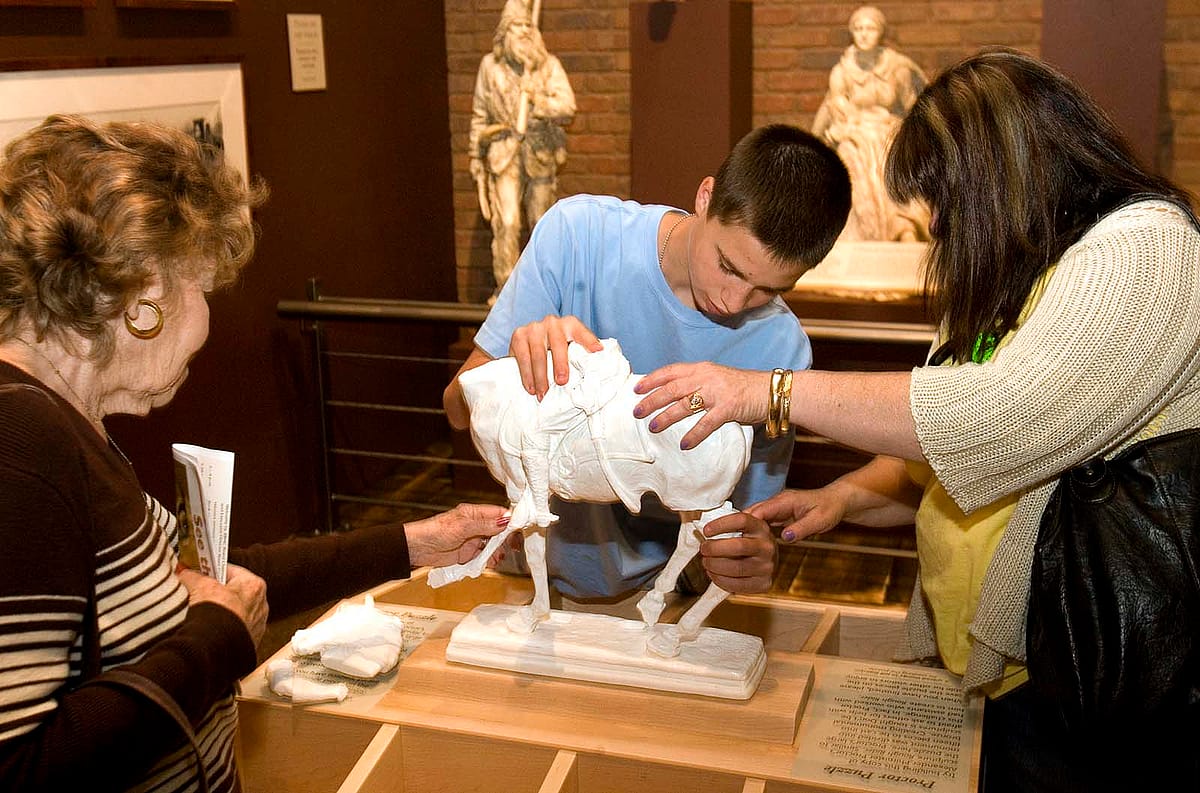
My favorite interpretive addition has to be the three label-writing stations found. While I may not be an art expert, these stations give me the chance to reflect on a particular piece, put those reflections in writing, and leave my completed label behind to share with others. The experience of writing one’s own label is a reminder that it’s not important to find the right or wrong answers when examining artwork, but rather discover a personal connection to it: Do I love a piece? Do I hate it? Does it remind me of a place I’ve been before? Does it stir an emotion? Does it make me want to learn more about a time in history? Will it be the one piece I still remember a year from now?
Since the Whitney Museum re-opened to the public June 21, 2009, I’ve enjoyed chatting with visitors as they explore the gallery and contemplate the answers to these questions and many more. From my hours spent there, I’ve found that almost everyone who enters the gallery is in awe. Some, like one preschooler I saw staring up with wonder at Thomas Moran’s painting, The Grand Canyon of the Yellowstone [on loan for the reopening; since returned to the Smithsonian’s American Art Museum], take the time to sit and contemplate a single piece for a while. “Wow, Grandma,” I overheard him say. “That’s really big! That must be a really big piece of paper. I bet that took lots of days to make. It probably came in a big truck.” I’d say art can evoke a sense of wonder in many different ways.
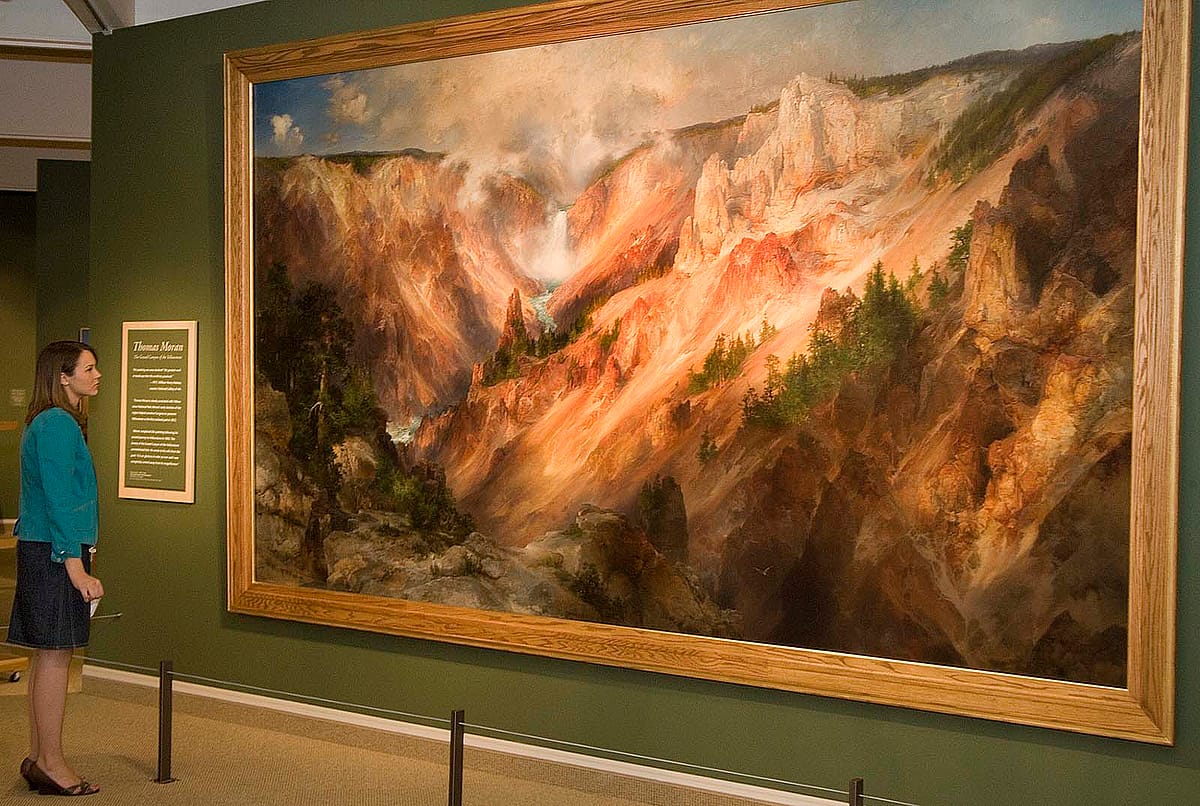
Others simply marvel at the gallery as a whole, pleasantly surprised to find such an impressive collection. “This museum is so spectacular,” said John Zumpano of Livingston, Montana, who visited the day of the public opening. “It’s hard to imagine, in a town of this size, a museum that would not be out of place in New York or Los Angeles.” Ann Lanoue of St. Paul, Minnesota, visiting with her husband Bill, echoed Zumpano’s sentiments, saying, “We’ve been to galleries in Germany, France, Chicago, and New York, and this is world class.”
The Lanoues, who attended the grand opening celebration, arranged their vacation itinerary to ensure they would not miss seeing the Whitney Museum. “Initially, we planned to visit the day before it opened,” Ann said. “We rearranged our visit so we would be able to be here for the opening.” For others, like Christine Arab of Neptune Beach, Florida, and her family, stopping at the Center just in time to attend the grand opening was pure happenstance. “We just felt like it was serendipity,” she said.
The visitors with whom I’ve spoken, particularly those who had visited the Whitney before the reinstallation, all seemed to agree that the many changes have made it a truly user-friendly space. “I like having it more open,” said George Bumann of Gardiner, Montana. “Some paintings have a lot more strength when you can see them across the room. The old Whitney seemed boxed in.”
Peggy and Kevin Kellett of Saratoga Springs, New York, said they, too, appreciated the gallery’s layout, and felt it was conducive to enjoying the work of familiar artists as well as discovering new favorites. “I think it’s set up nicely because you’re really supposed to be exposed to things you wouldn’t gravitate toward otherwise,” Peggy said. “I’ve always loved Remington, but I’m being introduced to all these artists I wasn’t aware of.”
I’ve spoken with many visitors since the museum reopened, but something that Susie Phillips from Cincinnati, Ohio, said was especially memorable to me. “You’re very, very fortunate to spend your days in here with all this beauty,” she told me. She’s right. Even though most of my days are actually spent in the public relations office, a short walk from the Whitney, I do feel fortunate for all the time I’ve been able to spend there. I never drove a nail or hung a single painting during the nine-month reinstallation process, but simply being here at the Center for such a momentous occasion has left me with a certain sense of pride and ownership in the Whitney Museum.
It’s difficult to believe I once hardly cared about the marvelous collection of art on display right here in my own hometown. Now, I find myself bragging about the gallery to my friends and insisting they come see it for themselves. As my summer comes to a close and I reflect on my internship at the Buffalo Bill Center of the West, I realize there’s one thing I gained that I never expected: an appreciation for western art that surely will keep me coming back to the Whitney Museum long after my days as an intern are over.
About the author
At the time this article was written, Laurel Eatherly was a junior majoring in English and communications at Lake Forest College in Illinois. She was one of a dozen Center interns in the summer of 2009. A graduate of Cody High School, her long-term plans were still somewhat undecided, but in late summer 2009 she set sail with the University of Virginia’s 100th Anniversary Semester at Sea, August 28 – December 14. Students left port from Nova Scotia for an around-the world voyage that included eleven countries in 109 days, with a return to San Diego. Now Laurel Fasl, she recently earned her Masters in Education (Human Resource Development) and lives in Chicago.
Post 317
Written By
Nancy McClure
Nancy now does Grants & Foundations Relations for the Center of the West's Development Department, but was formerly the Content Producer for the Center's Public Relations Department, where her work included writing and updating website content, publicizing events, copy editing, working with images, and producing the e-newsletter Western Wire. Her current job is seeking and applying for funding from government grants and private foundations. In her spare time, Nancy enjoys photography, reading, flower gardening, and playing the flute.

